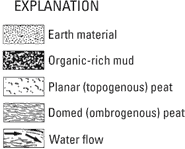
Figure 23. Sketches illustrating a possible evolution from a planar (topogenous) peat deposit to a domed (ombrogenous) peat deposit. A, planar; B, transitional, slightly domed; and C, domed. A planar deposit may evolve into a transitional or domed deposit if climatic conditions change; the two types of peat deposits also may occur independently. No scale implied, but the horizontal dimension could be many miles and the vertical dimension could be 500 to 1,000 ft. Individual plant types were not identified in the source for this figure, but a typical flora might include cypress, magnolia, and willow trees; sassafras, sumac, and witch hazel shrubs; and ferns, reeds, and lilies as low-growing and water plants. Modified from McCabe (1987), used with permission of The Geological Society (London).

